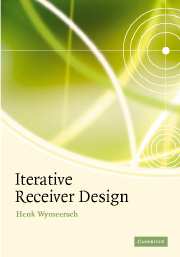Book contents
- Frontmatter
- Contents
- Preface
- Abbreviations
- Notations
- List of algorithms
- 1 Introduction
- 2 Digital communication
- 3 Estimation theory and Monte Carlo techniques
- 4 Factor graphs and the sum–product algorithm
- 5 Statistical inference using factor graphs
- 6 State-space models
- 7 Factor graphs in digital communication
- 8 Decoding
- 9 Demapping
- 10 Equalization–general formulation
- 11 Equalization: single-user, single-antenna communication
- 12 Equalization: multi-antenna communication
- 13 Equalization: multi-user communication
- 14 Synchronization and channel estimation
- 15 Appendices
- References
- Index
3 - Estimation theory and Monte Carlo techniques
Published online by Cambridge University Press: 08 January 2010
- Frontmatter
- Contents
- Preface
- Abbreviations
- Notations
- List of algorithms
- 1 Introduction
- 2 Digital communication
- 3 Estimation theory and Monte Carlo techniques
- 4 Factor graphs and the sum–product algorithm
- 5 Statistical inference using factor graphs
- 6 State-space models
- 7 Factor graphs in digital communication
- 8 Decoding
- 9 Demapping
- 10 Equalization–general formulation
- 11 Equalization: single-user, single-antenna communication
- 12 Equalization: multi-antenna communication
- 13 Equalization: multi-user communication
- 14 Synchronization and channel estimation
- 15 Appendices
- References
- Index
Summary
Introduction
Before we can even consider designing iterative receivers, we have a lot of ground to cover. The ultimate goal of the receiver is to recover optimally the sequence of information bits that was sent by the transmitter. Since these bits were random in the first place, and they are affected by random noise at the receiver, we need to understand and quantify this randomness, and incorporate it into the design of our receiver.We need to specify what it means to recover optimally the information bits from the received signal. Optimal in what sense? To answer this problem, we call on estimation theory, which will allow us to formulate a suitable optimization problem, the solution of which will give our desired optimal data recovery. Unfortunately, as is common to most optimization problems of any practical relevance, the issue of finding a closed-form solution is intractable. There exists a set of tools that can solve these problems approximately by means of sampling. They go under the name of Monte Carlo (MC) techniques and can help in describing difficult distributions, and in obtaining their characteristics, by means of a list of samples. These MC methods will turn out to be very useful in the factor-graph framework.
This chapter is organized as follows.
We will start with the basics of Bayesian estimation theory in Section 3.2, covering some important estimators both for discrete and for continuous parameters.
In Section 3.3, we will provide a brief introduction to MC techniques, including particle representations of distributions, importance sampling, and Markov-chain Monte Carlo (MCMC) methods.
- Type
- Chapter
- Information
- Iterative Receiver Design , pp. 19 - 34Publisher: Cambridge University PressPrint publication year: 2007
- 1
- Cited by



